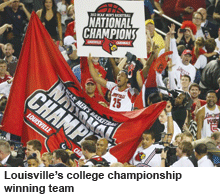United States: Varsity sports money challenge
So gruesome was the injury to Kevin Ware’s leg that most media outlets declined to show it. Not often does a young man’s tibia break clean through his skin in the course of a college basketball game. Yet Ware urged his University of Louisville team-mates to carry on without him, which they did, winning the college championship on April 8.
Ware’s story inspires. It also sells. Shortly after his bone was set, Louisville began hawking shirts referring to him (they were withdrawn when uproar ensued). Ware also became the focus of coverage on CBS, one of two broadcasters which pay the National Collegiate Athletic Association (NCAA) nearly $800 million (Rs.4,400 crore) a year to air ‘March Madness’, as the men’s college-basketball tournament is known.
 Lucrative TV contracts, licencing fees, merchandising and ticket sales have long turned college sport into a multi-billion-dollar industry. The NCAA estimates that in the academic year 2010-11 its member-institutions spent about $12 billion (Rs.66,000 crore) on athletics and generated about $6 billion in revenue. But though less popular sports like wrestling and rowing drain resources, the leading men’s football and basketball teams make tens of millions for their universities. As one example, Louisville’s basketball team, sponsored by Adidas and playing in the KFC Yum! Centre, turned a $27 million (Rs.145 crore) profit in the last school year.
Lucrative TV contracts, licencing fees, merchandising and ticket sales have long turned college sport into a multi-billion-dollar industry. The NCAA estimates that in the academic year 2010-11 its member-institutions spent about $12 billion (Rs.66,000 crore) on athletics and generated about $6 billion in revenue. But though less popular sports like wrestling and rowing drain resources, the leading men’s football and basketball teams make tens of millions for their universities. As one example, Louisville’s basketball team, sponsored by Adidas and playing in the KFC Yum! Centre, turned a $27 million (Rs.145 crore) profit in the last school year.
None of that trickled down to Ware. Under the strict rules of the NCAA, student athletes are not paid for the value they create. Many do get free education, as well as room and board, a package which can be worth more than $50,000 (Rs.27.5 lakh) a year. Defenders of the system say that is plenty.
Yet critics say a scholarship is hardly commensurate with the value of some student athletes. Take Johnny Manziel, the star quarterback at Texas A&M University. According to a study by Joyce Julius & Associates, a research firm, Manziel generated $37million (Rs.202 crore) worth of media exposure for his school last year. Under the rules, he is not allowed to profit from his performance. But critics allege the NCAA and its members are doing just that. A replica of his number 2 jersey can be bought for around $60 in the university’s online store, and his avatar will appear in an officially licenced videogame.
Similar complaints can be found in an antitrust lawsuit that poses a threat to the current system. The initial challenge was brought in 2009 by Ed O’Bannon, a former basketball player for the University of California, Los Angeles, who tired of seeing his image used in ways that profited only the NCAA and its licencees. He has since been joined by other former college stars. In June, a judge will decide whether to certify the lawsuit as a class action involving all current and former student athletes.
If that happens, the NCAA will face astronomical claims. O’Bannon and company want a share of everything from TV contracts to trading-card deals. A settlement upending the system would be the most likely result. Such a deal might set aside a portion of the revenue generated by elite college sports to pay ex-players and create a trust to compensate current student athletes when they graduate. But it would also raise thorny questions, not least over how the money is divided.
Pendulum swung too far
Undergraduate-led learning is helping to create a generation of narcissistic students convinced of their own self-worth and dismissive of academics’ expertise. This is the view of Ann O. Watters, assistant clinical professor of psychiatry at the University of California, San Francisco, who says the pendulum has swung too far in favour of valuing student contributions.
Writing in the latest edition of The Journal of General Education, Dr. Watters who is also emeritus lecturer at Stanford University’s programme in writing and rhetoric, and a practising clinical psychologist, says the move away from traditional teacher-led lectures had not been entirely negative. “Ditching the teacher-centred, authoritarian pedagogy many mature academics were trained in… seemed like a good idea,” she writes. “Promoting active and engaged students, appealing to student interest and promoting a more community-based and democratic enterprise made sense.”
However, today’s student-led learning environment, which stresses the importance of student voices and experiences, has led to a loss of teachers’ authority within the classroom, she contends. Teachers report widespread resistance to critical feedback or evaluation, with students asserting that all opinions are equally valid and dismissing their instructor’s in-depth knowledge of a subject, Dr. Watters says. “If we and our pedagogy encourage such high opinions of student work, can we really be surprised when they take us at our word?” she asks.
Group discussions are often dominated by confident, talkative students and “overvalued trivial, idiosyncratic utterances and undervalued potential guidance from the more experienced”, she writes.
“We could strive to value more the subtle, quiet thinkers — the students who shine in their work and writing, but are not the active, constantly verbal, extroverted personalities who make our work easier by participating in discussions,” argues Dr. Watters.
(Excerpted and adapted from The Economist & Times Higher Education)















Add comment